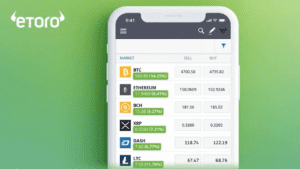Welcome to this comprehensive guide on crypto investment strategies tailored specifically for Europeans. As the world becomes increasingly digitized, the realm of cryptocurrency has evolved from a niche market into a significant financial ecosystem. Europe, with its progressive regulatory framework and burgeoning fintech sector, has become a fertile ground for crypto investments. However, the volatile nature of this asset class makes it imperative for investors to have a well-thought-out strategy.
The objective of this article is to provide you with an in-depth understanding of the European crypto landscape, the types of crypto assets available, and various investment strategies you can employ. Whether you’re a casual investor looking to dip your toes into the crypto pool or a seasoned asset manager seeking to diversify your portfolio, this guide aims to leave no question unanswered.
Stay tuned as we delve deep into the complexities of the crypto market, offering actionable insights to help you navigate this exciting yet challenging investment frontier.
The European Crypto Landscape
Regulatory Environment
The regulatory landscape for cryptocurrencies in Europe is relatively progressive compared to other regions. The European Union (EU) has been proactive in establishing a legal framework, primarily through the Markets in Crypto Assets (MiCA) regulation. This aims to provide clarity on crypto assets classification, requirements for crypto service providers, and consumer protection measures.
Join the world's biggest trading network & get instant access to a personal account manager!
Key Regulatory Bodies:
- European Securities and Markets Authority (ESMA)
- Financial Conduct Authority (FCA) in the UK (for non-EU residents)
- National regulators like BaFin in Germany and AMF in France
Key Regulations:
- Anti-Money Laundering Directive (AMLD5)
- Markets in Crypto Assets (MiCA)
- General Data Protection Regulation (GDPR) for data privacy
Popular Exchanges and Platforms
Europeans have access to a plethora of exchanges and platforms, both centralized and decentralized. Here are some of the most popular ones:
Table: Popular Crypto Exchanges Accessible to Europeans
| Exchange | Headquarters | Features | Fiat Support |
|---|---|---|---|
| Binance | Malta | High liquidity, wide range of assets | EUR, GBP |
| Kraken | USA | Strong security, comprehensive features | EUR, GBP |
| Bitstamp | Luxembourg | User-friendly, good for beginners | EUR, USD |
| eToro | Cyprus | Social trading features | EUR, GBP, USD |
| Coinbase | USA | Easy to use, insured deposits | EUR, GBP |
Market Trends Specific to Europe
- Adoption of Decentralized Finance (DeFi): European investors are increasingly interested in DeFi platforms, which offer financial services without traditional intermediaries.
- Stablecoin Usage: The use of stablecoins like EURS, which is pegged to the Euro, is on the rise for hedging against volatility.
- Environmental Concerns: European investors are showing a growing interest in eco-friendly cryptocurrencies like Chia and Algorand, aligning with the EU’s sustainability goals.
Understanding Risk and Return
Volatility in the Crypto Market
The cryptocurrency market is notoriously volatile, with prices capable of making dramatic swings within short periods. For instance, Bitcoin saw a 30% drop in a single day in May 2021, only to recover partially in the following weeks. This volatility can be both an opportunity and a risk, depending on your investment strategy.
Table: Historical Volatility of Major Cryptocurrencies (2022)
| Cryptocurrency | 30-day Volatility | 90-day Volatility | 1-year Volatility |
|---|---|---|---|
| Bitcoin | 4.2% | 3.9% | 5.1% |
| Ethereum | 5.1% | 4.7% | 6.3% |
| Cardano | 6.0% | 5.5% | 7.2% |
Risk Tolerance and Investment Horizon
Understanding your risk tolerance is crucial in the crypto space. Are you comfortable with high volatility, or do you prefer stable returns? Your investment horizon—whether you’re looking for short-term gains or long-term growth—also plays a significant role in shaping your strategy.
The Risk-Return Tradeoff
In finance, the risk-return tradeoff dictates that higher returns come with higher risks. In the crypto market, this principle is magnified. For instance, while Bitcoin and Ethereum are considered relatively stable, they still carry more risk compared to traditional assets like bonds. On the other hand, newer, less-established cryptocurrencies can offer substantial returns but come with much higher volatility and risk.
Table: Risk-Return Profiles of Selected Crypto Assets
| Asset | Estimated Annual Return | Risk Level | Recommended for |
|---|---|---|---|
| Bitcoin | 20-40% | Moderate | Most investors |
| Ethereum | 25-50% | Moderate | Most investors |
| DeFi Tokens | 40-80% | High | Risk-tolerant investors |
| NFTs | Variable | Very High | Speculative investors |
By understanding the European crypto landscape and the intricacies of risk and return, you can make more informed decisions tailored to your investment goals and risk tolerance. Stay tuned as we delve into the types of crypto assets and various investment strategies in the following sections.
Types of Crypto Assets
Navigating the crypto market requires a deep understanding of the various types of assets available. Each asset class has its own set of characteristics, risk profiles, and potential returns. Let’s delve into the primary categories.
Cryptocurrencies (Bitcoin, Ethereum, etc.)
Cryptocurrencies like Bitcoin and Ethereum are digital or virtual currencies that use cryptography for security. They operate on decentralized networks, typically based on blockchain technology.
- Bitcoin (BTC): Often referred to as digital gold, Bitcoin is the first and most well-known cryptocurrency. It serves as a store of value and is widely accepted for transactions.
- Ethereum (ETH): More than just a cryptocurrency, Ethereum also enables smart contracts and distributed applications (DApps) to be built and run without any downtime, fraud, or interference from a third party.
Table: Market Capitalization of Major Cryptocurrencies (as of 2022)
| Cryptocurrency | Market Capitalization (in billions) | Key Use Case |
|---|---|---|
| Bitcoin | $900 billion | Store of Value |
| Ethereum | $400 billion | Smart Contracts, DApps |
Tokens (Utility, Security)
Tokens are a type of crypto asset that represent a unit of value issued by a project. They are often launched through an Initial Coin Offering (ICO) or a Token Generation Event (TGE).
- Utility Tokens: These tokens provide users with access to a specific application or service within a blockchain ecosystem. Examples include Chainlink (LINK) and Uniswap (UNI).
- Security Tokens: These are digital assets subject to federal securities regulations. They often represent ownership in an external asset, like real estate or stocks.
Stablecoins
Stablecoins are cryptocurrencies designed to minimize volatility by being pegged to a reserve asset, usually a fiat currency like the US Dollar or the Euro.
- Tether (USDT): Pegged to the US Dollar
- EURS: Pegged to the Euro, popular among European investors
NFTs (Non-Fungible Tokens)
NFTs are unique digital assets verified using blockchain technology. They have gained popularity for their use in representing ownership of unique items like art, collectibles, and even real estate.
- Artwork: Digital art pieces can be tokenized as NFTs.
- Collectibles: From trading cards to virtual pets, NFTs are used to prove ownership of unique collectibles.
Investment Strategies
Investing in crypto assets requires a well-thought-out strategy, tailored to your risk tolerance and financial goals. Here are some common investment approaches:
Long-term Holding (“HODLing”)
The term “HODL” originated from a misspelled word “hold” and has become a strategy where investors buy and hold cryptocurrencies for extended periods, regardless of price volatility. This strategy is best suited for assets with strong fundamentals and long-term viability, like Bitcoin and Ethereum.
Active Trading
Active trading involves buying and selling crypto assets in the short term to profit from market fluctuations. This strategy requires a good understanding of market analysis techniques, such as technical and fundamental analysis. Popular platforms for active trading accessible to Europeans include Binance, Kraken, and Bitstamp.
Yield Farming and Staking
Yield farming and staking involve lending your crypto assets to earn rewards or interest. These strategies are popular in the Decentralized Finance (DeFi) space and can offer high returns, albeit with higher risks.
- Yield Farming: Providing liquidity or participating in a lending protocol to earn rewards.
- Staking: Holding and locking up a cryptocurrency to participate in running a blockchain in return for rewards.
Diversification Strategies
Diversification involves spreading your investments across different types of assets to reduce risk. A diversified crypto portfolio might include a mix of cryptocurrencies, tokens, stablecoins, and even NFTs.
Tax Optimization
Given the complex and evolving tax regulations around crypto assets in Europe, tax optimization strategies can be beneficial. These may include timing your buy and sell actions for long-term capital gains or leveraging tax-loss harvesting.
Tools and Resources
In the ever-evolving world of crypto investments, having the right tools and resources at your disposal can make a significant difference in your investment outcomes. From secure storage solutions to advanced analytics platforms, let’s explore some essential tools that can help you navigate the European crypto landscape more effectively.
Wallets and Storage Solutions
The first step in your crypto investment journey is to find a secure place to store your assets. Wallets come in various forms, each with its pros and cons.
- Hardware Wallets: Devices like Ledger Nano S and Trezor offer the highest level of security by storing your private keys offline. Ideal for long-term investors.
- Software Wallets: These are applications that can be installed on your computer or smartphone. Examples include MetaMask and MyEtherWallet. Convenient but less secure than hardware wallets.
- Custodial Wallets: Offered by exchanges like Coinbase and Binance, these wallets are easy to use but give the exchange control over your assets.
Research Platforms and Analytics Tools
In-depth research is crucial for successful crypto investing. Various platforms provide comprehensive data, analytics, and insights.
- CoinMarketCap: Offers data on thousands of cryptocurrencies, including market cap, volume, supply data, etc.
- TradingView: A popular platform for charting and technical analysis, widely used for both crypto and traditional markets.
- Messari: Provides advanced analytics, including token metrics, sector trends, and research reports.
Risk Management Software
Managing risk is paramount in the volatile crypto market. Several software solutions can help you set stop-loss limits, track your portfolio, and even automate trading strategies.
- 3Commas: Allows you to set up automated trading strategies and offers portfolio tracking.
- CoinTracking: Provides a comprehensive view of your portfolio and helps with tax reporting.
- Delta: A portfolio tracker that offers insights into your investments and potential future scenarios.
Case Studies
Learning from real-world examples can offer invaluable insights into what to do—and what not to do—in the crypto market. Let’s look at some case studies that highlight both success stories and lessons from failures.
Success Stories
- Bitcoin Early Adopters: Those who invested in Bitcoin in its early days and held onto their investments have seen astronomical returns. For instance, an investment of $100 in Bitcoin in 2010 would be worth millions today.
- DeFi Yield Farmers: Some early participants in DeFi protocols like Compound and Yearn Finance have earned substantial yields, sometimes exceeding 100% APY.
Lessons from Failures
- Mt. Gox Collapse: Once the world’s largest Bitcoin exchange, Mt. Gox filed for bankruptcy in 2014 after losing 850,000 Bitcoins. This serves as a cautionary tale about the risks of using insecure platforms.
- ICO Scams: The 2017-2018 ICO boom saw numerous projects that failed to deliver on their promises or were outright scams. Investors lost substantial amounts, highlighting the importance of due diligence.
By leveraging the right tools and learning from both successes and failures, you can make more informed decisions and optimize your investment strategy. In the next section, we will delve into the legal and tax considerations that are crucial for European crypto investors. Stay tuned.
Legal and Tax Considerations
Navigating the crypto market isn’t just about understanding assets and strategies; it’s also crucial to be aware of the legal and tax implications of your investments. In this section, we’ll explore the regulatory landscape at both the European Union and national levels, as well as the tax considerations you should be aware of.
European Union Regulations
As mentioned earlier, the European Union has been proactive in regulating the crypto space. The Markets in Crypto Assets (MiCA) regulation aims to provide a comprehensive framework for crypto assets and their service providers. Compliance with Anti-Money Laundering (AML) and Counter-Terrorism Financing (CTF) regulations is also mandatory for platforms operating within the EU.
National Laws and Guidelines
In addition to EU-wide regulations, individual countries have their own sets of laws and guidelines concerning cryptocurrencies. For instance:
- Germany: BaFin has classified cryptocurrencies as units of account and therefore financial instruments.
- France: The Autorité des Marchés Financiers (AMF) has a whitelist of approved ICOs and requires crypto service providers to register.
Tax Implications
Tax treatment of crypto assets varies across European countries, but there are some common themes:
- Capital Gains Tax: Most European countries tax the capital gains from crypto trading.
- Income Tax: Earnings from mining or staking activities are generally considered income and are subject to income tax.
- VAT: In most EU countries, transactions involving cryptocurrencies are exempt from Value Added Tax (VAT).
Understanding the legal and tax landscape can save you from potential pitfalls and ensure that your investment journey is compliant with existing regulations.
Conclusion
Summary of Key Takeaways
We’ve covered a lot of ground in this comprehensive guide, from understanding the European crypto landscape and types of crypto assets to exploring various investment strategies and essential tools. Legal and tax considerations have also been discussed to provide you with a holistic view of what it takes to invest in cryptocurrencies in Europe.
Final Thoughts and Next Steps
The crypto market offers a plethora of opportunities, but it’s not without its risks and complexities. Armed with the insights from this guide, you’re better positioned to navigate this exciting yet challenging investment frontier. Your next steps should involve further research, possibly leveraging some of the tools and platforms mentioned, and perhaps consulting with financial and legal advisors to tailor a strategy that fits your individual needs and risk tolerance.
Additional Resources
Books, Podcasts, and Courses
- Books: “The Bitcoin Standard” by Saifedean Ammous, “Cryptoassets” by Chris Burniske and Jack Tatar
- Podcasts: “Unchained” by Laura Shin, “The Daily Stoic” for investment psychology
- Courses: “Cryptocurrency Investment and Retirement Planning” on Udemy, “Blockchain Basics” on Coursera
Websites and Forums for Further Learning
- Websites: CoinDesk, Cointelegraph for news and analysis
- Forums: Reddit’s r/cryptocurrency, Bitcointalk.org for community discussions
By continuously educating yourself and staying updated on market trends, you can make more informed decisions and optimize your investment strategy. Thank you for reading, and here’s to your success in the crypto market!

















